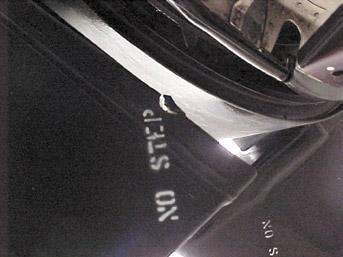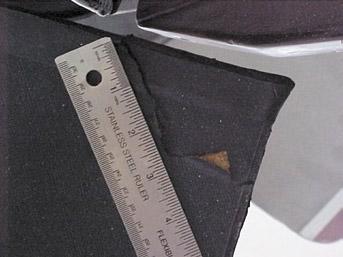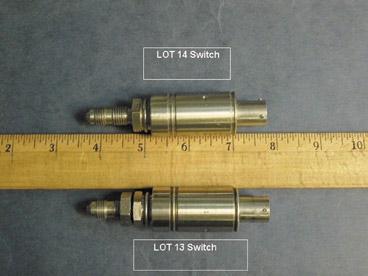
11 minute read
Day the Lights Went Out
during FOD walkdowns. Everyone must understand that the walkdown process is merely a means to collect information to determine how to proceed with a prevention program, and it is only as valuable as the information gleaned from examining the FOD collected. A critical eye examining the material collected during FOD walkdowns should determine its origin. Then push those findings down to the deck plates to emphasize proper housekeeping. Young maintainers must understand where FOD originates in order to successfully prevent it from migrating to the flight deck and flight line. They must understand the monetary and manpower costs relative to the organization and make sure the prevention process mitigates the risks.
Producing Positive Outcomes
Advertisement
The answer to the question, “What costs will the command afford in terms of losses in readiness attributed to FODs?” is “none.” We established an aggressive fastener-integrity program, improved housekeeping, and have not experienced a single FOD from loose, faulty or missing fasteners. Aircrew, QA, maintenance control, and work-center leadership communicate the risks and are fully engaged in the prevention process. This increased awareness and proactive approach has mitigated the hazards and reduced engine replacement and maintenance man-hour costs.
These steps, along with all-hands participation, are critical for effective prevention. We have reduced our FOD occurrences 50 percent over the previous year and aligned our efforts to eliminate the risk of FODs completely in the year to come. It proves a squadron can follow the book, improve safety procedures, and still continue to operate at the tip of the spear.
Lt. Turner was the MMCO when this story was written. CWO4 Ron Stebbins assisted Lt. Turner and recently reported to the Naval Safety Center.
WESS BRT NEWS Information on WESS is available on the Naval Safety Center website (www.safetycenter.navy.mil/wess). Visit and see stories, FAQs and videos on efforts to improve this valuable and required program.
By AM2 Michael Holthaus
My whole world turned black one sunny day around 1330. I was on my hands and knees, feeling around to figure out how to get out from under a turning jet and wondering if I could see. I never have been so scared.
I had been called to one of our jets because hydraulic fluid was all over the port keel. The team got set up for a low-power turn. After a little investigation, I found the leak, which, to tell the truth, was in an awkward place. We shut down the jet and did the necessary fixes.
I set up for another turn, and, to my dismay, the leak came back. In a moment of divine wisdom, I grabbed a wrench and decided to see if I could stop the flow. I probably don’t have to remind anyone, but a charged line is pressurized to 3,000 psi. At the time, I was wearing dark lenses and barely could see, so I kicked back my goggles—like so many maintainers do at one time or another. What a big mistake!
With my face just 10 inches away from the spot where I was working, I pushed up on the wrench, and the line sheared, causing a large shot of hydraulic mist to blow back in my face, engulfing my head. My eyes shut instantly. I started to fall backward and then to the side. I jumped back up and motioned for the plane captain to shut down the aircraft. The plane captain was stunned, so I tried again to signal for shut down. At this
Day the Lights Went Out

Working under an aircraft without goggles or a cranial can be very dangerous. Navy photo by PH3 Aaron Burden
point, I began to crawl out from under the aircraft when I felt a shipmate grab me. He was pulling me in the right direction and asking me if I was all right. At that point, I couldn’t see and thought I was blind.
I was wearing a radio headset, so I called the flightdeck chief and told him I needed him now! Suddenly, the radio crackled, “Man down base! We need an ambulance!” The plane captain and chief stood me up and led me toward the hangar. It took 100 or so steps to reach the hangar and seemed to take forever. I could hear the diesel engines of the fire truck and ambulance, I remember thinking, “Wow, they got here fast.” I then was led to the eyewash station and started to flush out my eyes.
For those who never have used one in the Pacific Northwest, the water is freezing! They had me wash my eyes for what seemed like an eternity. The corpsman asked me for my name, rank and where I was, checking for shock. They then looked at my eyes and wiped off my face.
After a quick check, they loaded me into an ambulance and took me to a hospital. As I sat there, the adrenaline began to wear off, and I began to realize how close I had come to serious injury. Reflecting on the incident, I realize I might never have seen my son or watched my wife sleep again. I also might not ever have been able to see my unborn child.
I learned a very valuable lesson that day: PPE can protect you but only if you wear it. No matter how small the leak or how easy the task, wear goggles. You only have one set of eyes, and nothing is worth risking your sight.
Petty Officer Holthaus works in the airframes shop at VAQ-139.
By AE1 Cassandra Daniel

My squadron, like most in the Navy, is a complex unit tasked with high-tempo ops that include daily operational commitments and regularly scheduled aircraft maintenance. When the heat of action builds, everyone must be on the same page, and communications are critical. We recently had an incident that showed just how important.
An ISIS (isochronal scheduled inspection system) is an ideal example of regularly scheduled maintenance where tasking requires countless maintenance processes to Damaged blades are a big concern with any aircraft. occur so aircraft can be maintained and operated safely. To ensure an orderly completion of the ISIS, the steps are controlled and blades to be rotated, including static pitchlock through a sequence-control chart (SCC), which allows checks. several tasks to be worked on concurrently. Two electricians were assigned to complete the
The completion of technical directives (TDs) is static pitchlock checks on the No. 1 and No. 2 propelone of many requirements also done during an ISIS. lers. An AE2 was assigned to the flight station to begin Our first one on a deployment in Misawa, Japan, moving the propeller blades, and another AE2 was involved the completion of AYB-1055. This directive acting as the outside observer. They completed the requires we check the afterbody bolts for proper thread static checks on the No. 2 propeller without noticing count and nut plates for security. If any failure is found, anything unusual and then continued onto the No. 1 each failed bolt and nutplate must be replaced. propeller. The AE2 acting as outside observer imme
Power plants had to incorporate this particular TD. diately signaled the AE2 in the flight station to stop While complying with it, the squadron discovered sevbecause he noticed damage to the No. 1 blade cuff. At eral nut plates were bad. The technician left the bolts this point, they stopped all maintenance and immediin place to point out which nut plates were bad. ately reported the problem to maintenance control.
As previously mentioned, several procedures are Extensive damage occurred to the blade cuff on being done at the same time to complete the inspecthe No. 1 propeller and lesser damage to the No. 2 tion. Some of those procedures require the propeller propeller. The damage took place when the propeller




occurred during their particular maintenance action.
The result of this coordination failure was the loss of a propeller with a repair cost of $121,644 and damage to a second one. The command also had to expend extensive man-hours to repair and replace them. Although each individual denies responsibility for the damage to the propellers, it is clear that poor maintenance procedures and insufficient supervision were at fault.
The maintenance instruction manual does not state that the afterbody bolts should be removed immediately, but this critical step
This close-up shows how bad it can get. clearly should have been taken after completing the inspection. The bolts then should have been marked and stored for accountability. As maintenance professionals, we must have total situational awareness, especially at the supervisory level, about concurrent tasks that involve multiple work centers. Maintainers assigned to complete any maintenance action must do an operational risk management (ORM) assessment before beginning any job. It was determined that the propeller damage could have occurred over several days and possibly on separate occasions. Without personal accountability and integrity, it is impossible to know exactly when or how it occurred.
Several people could be at fault, but no one knows who’s guilty. All maintenance personnel received training on the proper steps to incorporate AYB-1055 and blades were rotated and came into contact with afterthe importance of not leaving afterbody bolts in the body bolts left in the wagon-wheel structure of both wagon wheels after removing the afterbody. Our entire engines after completing AYB-1055. department also reexamined the most important char
Power-plants personnel were assigned and comacter trait when it comes to maintenance safety and the pleted servicing on all of the propellers. The electrioperation of aircraft: integrity. cians cleaned the slip-ring assemblies and installed QA also submitted a technical-publications defithe brush blocks. These actions required the blades/ ciency report (TPDR) on NA-01-75PAA-2-4.6. They propellers to be rotated. requested a caution be included to highlight the
Where was the breakdown? When exactly did the damage that can occur if the afterbody bolts are left in damage occur? Each maintainer involved with jobs without the afterbodies being installed. done during the ISIS was adamant that no damage had Petty Officer Daniel is the ground-safety petty officer at VP-40.




By AME1 Morrison
Our Hornet squadron’s workload was heavy, but A closer look showed that the MSP 833 code had we were used to it. Maintenance control asked returned. We troubleshot some more and again found us to troubleshoot an MSP 833 code (secondary the switch bad. I ordered another switch and passed the bleed-air overpressure switch). The same discrepancy job to night check. Maintenance control directed the existed on the last five flights. That obvious sign should shop to cannibalize the switch from another jet. The have caught our attention; it didn’t. MSP 833 code still was present after they replaced the
We followed the troubleshooting procedures in the switch. Further troubleshooting revealed pin 111 on the publications and found the secondary bleed-air overpresSDC was pushed and had caused the MSP code 833. sure switch was bad. I went to the publication for the The AE shop repaired the pushed pin, and the MSP part number and ordered the switch. We installed it and code 833 cleared. did a low-power turn to verify it worked and checked for Maintenance control discussed the gripe at length leaks. After 20 minutes of turning the jet, the MSP 833 with the shop and concluded that something other did not appear, and the system worked as advertised. As than the recessed pin must have caused the bleeds to far as we were concerned, the aircraft was ready for the shut off. Night check found the wrong switch had been next day’s flight schedule. ordered both times, and the cannibalized switch was
During the next flight, the pilot received dual wrong, too. I had failed to check the “usable on” code bleed-off cautions, no ECS flow, and no OBOGS. While before ordering the switch. The ones installed were returning to the ship, the pilot could not transfer 2,000 for lot 13 aircraft, and this aircraft was a lot 14. The pounds of fuel from the two drop tanks. Our XO called switches physically looked identical, but the operating the shop and asked if the pilot could do anything to get characteristics were different. The lower lot switch has the ECS working again. I recommended cycling the lower pressure parameters, which caused the primary bleeds, and he told me they already had tried it, with no regulating valve and secondary valve to shut off once the luck. He made the call to jettison both drop tanks and aircraft reached afterburner off the catapult shot. land. The pilot returned to the ship safely. Looking back, I realized my first mistake was ordering the first part number on a list of three without checking the “usable on” code. The second mistake came when we swapped switches between different lot aircraft without checking the pubs. Our squadron learned a valuable lesson about maintaining different lot aircraft. You have to check everything against the pubs and can’t rely on the local subject-matter expert. It is just as important to take time and make sure your troops know how to use the pubs; it will save time in the long run. We were fortunate on this flight. The cost of the lesson, however, was two drop
Managing parts for multi-lot aircraft can be a challenge. tanks.












